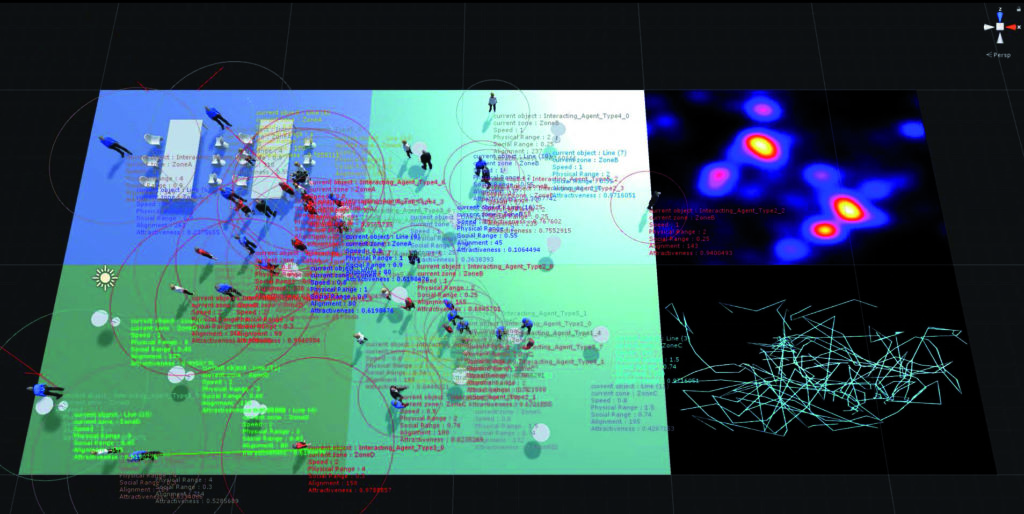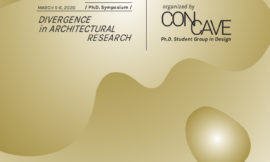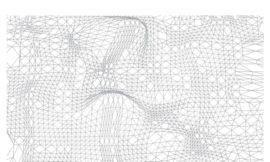I contributed a chapter on Simulation Tools for Social Performance to the recently published The Routledge Companion to Paradigms of Performativity in Design and Architecture. This book, edited by Mitra Kanani, focuses on a non-linear, multilateral, ethical way of design thinking and expands on the multiple facets and paradigms of performative design thinking as an emerging trend in design methodology.
Here is a short excerpt from my chapter Simulation Tools for Social Performance – Immersive Building Simulations that talks about agent-based simulations as a tool to optimize a space’s social performance. This short excerpt is for non-commercial internal, academic and research purposes only Please do not copy or distribute. The entire text can be found in the book – please consider buying it.
Agent-based Occupancy Simulations
Robert R. Neumayr
But also on a smaller scale, the analysis and prediction of spatial occupation patterns in various social spaces, most notably office environments, has moved more and more into the focus of contemporary design research recently, as a growing percentage of any developed country’s economy relies on intellectual capital rather than the means of production. Shifting away from the traditional Taylorist work culture with its long-established linear production logic, where the success of different spatial layouts could be easily measured (for example by simple counting the number of completed transactions, as routine assignments were handed down from one worker to the next), office tasks have become increasingly complex and knowledge driven. In Western European countries knowledge economy at this point represents about a third of all economic activities (Eurostat, 2013).
As work procedures became more flexible and spatial occupation patterns more loose and varied, and consequently could no longer be organized and measured according to Taylorist principles, new methods of assessing the performance of spaces need to be developed. Designers, such as the German Quickborner team with their Bürolandschaft concept, started in the 1970s to map the spatial relations between all agents in an office network in two-dimensional matrixes in order to find optimized office layouts. However, these design methodologies were still based on the clear assumption, that there is a linear relationship between the efficiency of a spatial layout and its successful work output.
In knowledge economies employees increase their respective radius of interaction due to the business’s intrinsically networked nature and various new types of knowledge work with their particular needs and mobility patterns emerge (Green and Myerson, 2011). The exchange of work is less vital than information interchange, communication, and human interaction, and the success of contemporary office environments increasingly relies on continuous formal and informal exchange of information and knowledge between actors in various different configurations. A space’s performativity largely depends on its capacity to spatially and semiologically frame the complexly interwoven interactions of its users.
In such a dynamic environment behavioral patterns are no longer linear but rather start to show emergent and unpredictable properties, which are the result of the repeated superimposition of (comparatively simple) interactions of its single constituent components (its agents), which gradually add up to the complex state of the emerging system. The result of such a non-linear process can no longer be predicted. This is also known as a “bottom-up” process, as opposed to a “top-down” process, in which the overall form is determined first. Such emergent systems however can be simulated by programming sets of simple agents that continuously interact with each other according to a basic set of rules. This was first achieved in 1987 by Craig Reynolds, who with his simulation program “Boids” successfully simulated the flocking behavior of birds. While such Agent Based Models (ABM) have been commonly used to simulate physical, chemical, biological, or sociological processes, architecture has only recently discovered their use for the simulation of life processes. Similar to a flock of birds or a school of fish, human crowds show complex non-linear behavior that is the result of a single agent’s behavioral rules or scripts that in turn are triggered by fellow agents or environmental features. As a consequence they constitute emergent systems, that can be successfully simulated by Agent Based Models (ABM). While plenty of commercial software programs, such as Cinema4D or Maya, offer readily available tools for crowd simulation, more complex life-like occupancy simulations at this point still require some scripting knowledge and the use of more specialized programs such as NetLogo (an open source program developed for an academic community) or Unity with its scripting extension (initially developed for the gaming industry).
Agent based design research is normally directed towards a concrete focal task in the form of a design research brief that acts as a experimental setup in relation to which empirical and statistical knowledge, conceptual and theoretical resources, simulation methodologies, and design ideas can be systematically brought together and explored.
In order to measure the different qualities and quantities of the agents’ interactions with each other, as well as with their environment, research focuses on the location, size, shape, configuration and features of informal office areas, such as communication zones, circulation areas and breakout spaces, where spontaneous communicative encounters and unscheduled opportunities for networking, collaboration and skill exchange most likely occur.
In order to set up a feasible first parametric model, the overall number of input parameters can be initially reduced within the conceptual framework of the simulation, gradually increasing complexity.
The main challenge is the development of a population of agents with plausible, life‐like individual behavioral rules that allow for the emergence of an overall plausible, life‐like collective event scenario. In order to accomplish this, any agent population needs to display two key properties of ‘life‐process modelling’. First of all, variable agent differentiation by status, affiliation, department, or position within the social network, implying behavioral difference, and secondly architectural frame‐dependency of behaviors, implying local selection from stacks of behaviors dependent on location and spatial architectural qualities.
The first property allows for the integration of client-specific employee structures and hierarchies, the second property facilitates a systematic semiological approach to the design, as it established relationships between the agents’ behavioral patterns and the furniture elements and features distributed across the space in question.
As the simulations run, systematically emulating various design proposals, relevant measures are recorded and stored to evaluate a scenario’s performance in terms of occupational patterns and communicative interaction. Those measures normally include location, frequency, relevancy and range of encounters and interactions as well as communicative histories, circulation patterns and occupancy maps (so called ‘heat maps”).

Simulations’ results can not only be summarized and compared in order to judge the performance of a particular office layout. Once the collected data is statistically analyzed and set in relation to the quantitative parameters, such as position and number of specific reference points and furniture elements, throughout a series of related simulation scenarios (thus parametrically attaching it to the same spatial environmental features with changing locations), it can be used to train prediction algorithms in order to forecast agent behavior in novel and previously unsimulated scenarios.
Looking at statistical connections between the qualitative, i.e. semiological parameters of a spatial layout and its features, such as object design, environmental zoning or effective or affective conditions, and the behavioral patterns they generate might eventually lead to understanding the conception of office environments as an explicit design agenda to frame communication with a new and coherent system of architectural signification, rather than an intuitive participation in a historically evolving semiosis of the built environment, in order to develop an approach to architectural design that better engages with the opportunities and challenges of today’s networked society.
References:
Eurostat. (2013). Science, Technology and Innovation in Europe. Luxembourg: Publication Office of the European Union, p. 115.
Greene, C. and Myerson, J. (2011). Space for Thought: Designing for Knowledge Workers. In Facilities, Vol. 29 Issue: 1/2, pp.19-30, https://doi.org/10.1108/02632771111101304.



